Professional Development Report
(for teacher certification requirement at
North Georgia College and State University)
More of the World into Teaching World History:
The Annual meeting of the Southeast World History Association
October 23-24, 1998 at Clayton College and State University, Morrow Georgia
On Friday, October 23rd, I participated in the Southeast World History Association's annual conference at Clayton College. The association is made up primarily of college teachers of world history, but a growing number of secondary school teachers are joining-in as well. Educators at all levels are finally coming to the realization that teaching world history has connections throughout the public school spectrum, and needs to be comprehended as a whole if progress is going to be made. As a prospective secondary school teacher, myself, I know that the content in high school world history classes are very similar to those found in many college level world civilizations courses. While the college and university level is more advanced in research and content, the secondary
school level is more advanced in teaching and learning strategies. This conference
provided a platform for combining the strong points of each of these levels of public
education.
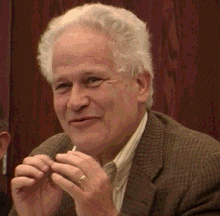 In the first panel discussion, a team of university history
professors warmed up the audience with a discussion titled "Good and Evil: Moralism
in World History." Daniel Klenbort of Morehouse College wove tales of his deceased
German-born mother and examples of a tendency among many historians to overlook Soviet
(and other) atrocities to humanity (e.g., holocausts, ethnic cleansing, etc.). In the
final analysis, he concludes that individuals not national entities, should be our main
focus moral judgments. Even then, however, we must remain conscious that our moral
judgment is more culturally-determined than universal. The professor gave us a humorous example of
the Mike Tyson's ear biting incident which caused outrage in the U.S. but would have been
perfectly acceptable in ancient Greece.
In the first panel discussion, a team of university history
professors warmed up the audience with a discussion titled "Good and Evil: Moralism
in World History." Daniel Klenbort of Morehouse College wove tales of his deceased
German-born mother and examples of a tendency among many historians to overlook Soviet
(and other) atrocities to humanity (e.g., holocausts, ethnic cleansing, etc.). In the
final analysis, he concludes that individuals not national entities, should be our main
focus moral judgments. Even then, however, we must remain conscious that our moral
judgment is more culturally-determined than universal. The professor gave us a humorous example of
the Mike Tyson's ear biting incident which caused outrage in the U.S. but would have been
perfectly acceptable in ancient Greece.
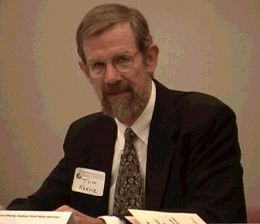 Thomas Keene of Kennesaw State University argues in his presentation of
"Colonialism and Metahistory: Beyond Good and Evil," that changes in human society during industrial revolution were just another phase of a species' skills
specialization in the long duree' of natural history. Colonialism can even be viewed as a
natural, or Darwinian phenomena, but it does not excuse its participants of moral
atrocities.
Thomas Keene of Kennesaw State University argues in his presentation of
"Colonialism and Metahistory: Beyond Good and Evil," that changes in human society during industrial revolution were just another phase of a species' skills
specialization in the long duree' of natural history. Colonialism can even be viewed as a
natural, or Darwinian phenomena, but it does not excuse its participants of moral
atrocities.
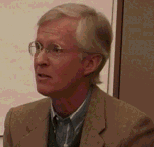 Finally, Douglas Reynolds of Georgia State University argues similarly, in his presentation of "Western
Christianity in Chinese History: Mission Schools in the 19th and 20th Centuries and their
Legacy," that Western moral institutions like Christianity evolve naturally into new
and indigenous forms when taken across cultural boundaries.
Finally, Douglas Reynolds of Georgia State University argues similarly, in his presentation of "Western
Christianity in Chinese History: Mission Schools in the 19th and 20th Centuries and their
Legacy," that Western moral institutions like Christianity evolve naturally into new
and indigenous forms when taken across cultural boundaries.
The main event between university and secondary school educators occurrs in the afternoon
in a panel discussion called New Ways of Teaching World History.
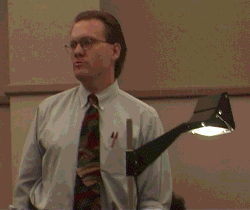 John I Brooks of Fayetteville State University began the session by introducing a
technique of teaching his introductory course in world civilizations course that allows more student involvement through group presentations of major segments of the course. At the beginning of the semester, students are divided into groups which are given the responsibility of reading related primary sources and presenting their conclusions collaboratively to
the class. Problems arise, however, when dividing the group assignments across the chronological
presentation of the course, but generally, the students enjoy the class more, according to
Professor Brooks.
John I Brooks of Fayetteville State University began the session by introducing a
technique of teaching his introductory course in world civilizations course that allows more student involvement through group presentations of major segments of the course. At the beginning of the semester, students are divided into groups which are given the responsibility of reading related primary sources and presenting their conclusions collaboratively to
the class. Problems arise, however, when dividing the group assignments across the chronological
presentation of the course, but generally, the students enjoy the class more, according to
Professor Brooks.
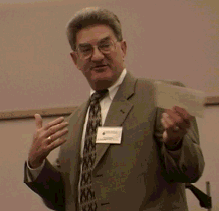 George Belden of North Georgia College and State University provided Professor Brooks with a theoretical explanation for increased student enjoyment in such an approach to teaching world history. In his presentation titled, "Using Learning Styles to Teach the Concept of Revolution in a World History Classroom," Professor Belden introduced the latest theory on learning types in the classroom. By adjusting teaching strategies to
appeal to a variety of learning types, we increase the chances or student success, or at
least mix up the traditional cross-section of successful students. It is not enough for
many students to simply be told why we are studying the American Revolution. They need to
realize it in a variety of ways.
George Belden of North Georgia College and State University provided Professor Brooks with a theoretical explanation for increased student enjoyment in such an approach to teaching world history. In his presentation titled, "Using Learning Styles to Teach the Concept of Revolution in a World History Classroom," Professor Belden introduced the latest theory on learning types in the classroom. By adjusting teaching strategies to
appeal to a variety of learning types, we increase the chances or student success, or at
least mix up the traditional cross-section of successful students. It is not enough for
many students to simply be told why we are studying the American Revolution. They need to
realize it in a variety of ways.
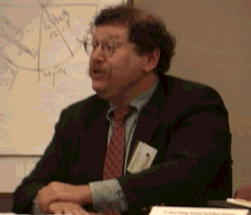 Marc Gilbert of North Georgia College and State University introduced his latest attempt
to adapt world history teaching methods to suit more learning styles. In "Teaching
World History in Georgia via Historical Sites," Professor Gilbert explained how he
works individually with students and pairs of students whom he advises in the completion
of a multi-media assignment to report on a historical site in Georgia from a world
historical perspective. For example, from a world historical perspective, an Etowah Mound
site in Georgia can be connected to the period in world history when peoples around the
world constructed temple and burial mounds. Similarly, a Martin Luther King memorial in
Atlanta can be seen in the world historical context of Gandhi's non-violent movement in
India. Professor Gilbert found that his students will choose an involved project like this
rather than do a simple report on a historical novel.
Marc Gilbert of North Georgia College and State University introduced his latest attempt
to adapt world history teaching methods to suit more learning styles. In "Teaching
World History in Georgia via Historical Sites," Professor Gilbert explained how he
works individually with students and pairs of students whom he advises in the completion
of a multi-media assignment to report on a historical site in Georgia from a world
historical perspective. For example, from a world historical perspective, an Etowah Mound
site in Georgia can be connected to the period in world history when peoples around the
world constructed temple and burial mounds. Similarly, a Martin Luther King memorial in
Atlanta can be seen in the world historical context of Gandhi's non-violent movement in
India. Professor Gilbert found that his students will choose an involved project like this
rather than do a simple report on a historical novel.
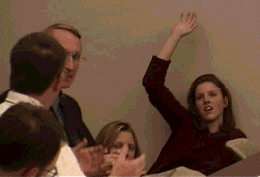 These professors' comments stimulate a heated discussion between college professors and
college students who came to observe the conference as a world history project.
Professor Schell of Murray State University (Kentucky) argued that since most students
taking his course still don't understand how to use a textbook properly, he finds it hard to set aside time for projects or student presentations. Several college students quickly respond that that they knew enough about textbooks and they would rather do something else in their classes. Hands-on projects connecting local sites, events, and people to world history is more exciting to many students than leaning how to use textbook indexes and bibliographies properly. Professor Schell was soon on the floor with a group of students discussing textbooks and alternative teaching methods. Professor Schell also states in a later discussion that "if he had the courage, he would be a secondary school teacher."
These professors' comments stimulate a heated discussion between college professors and
college students who came to observe the conference as a world history project.
Professor Schell of Murray State University (Kentucky) argued that since most students
taking his course still don't understand how to use a textbook properly, he finds it hard to set aside time for projects or student presentations. Several college students quickly respond that that they knew enough about textbooks and they would rather do something else in their classes. Hands-on projects connecting local sites, events, and people to world history is more exciting to many students than leaning how to use textbook indexes and bibliographies properly. Professor Schell was soon on the floor with a group of students discussing textbooks and alternative teaching methods. Professor Schell also states in a later discussion that "if he had the courage, he would be a secondary school teacher."
Certainly, more collaboration between secondary and post-secondary
school educators will benefit all!
 In the first panel discussion, a team of university history
professors warmed up the audience with a discussion titled "Good and Evil: Moralism
in World History." Daniel Klenbort of Morehouse College wove tales of his deceased
German-born mother and examples of a tendency among many historians to overlook Soviet
(and other) atrocities to humanity (e.g., holocausts, ethnic cleansing, etc.). In the
final analysis, he concludes that individuals not national entities, should be our main
focus moral judgments. Even then, however, we must remain conscious that our moral
judgment is more culturally-determined than universal. The professor gave us a humorous example of
the Mike Tyson's ear biting incident which caused outrage in the U.S. but would have been
perfectly acceptable in ancient Greece.
In the first panel discussion, a team of university history
professors warmed up the audience with a discussion titled "Good and Evil: Moralism
in World History." Daniel Klenbort of Morehouse College wove tales of his deceased
German-born mother and examples of a tendency among many historians to overlook Soviet
(and other) atrocities to humanity (e.g., holocausts, ethnic cleansing, etc.). In the
final analysis, he concludes that individuals not national entities, should be our main
focus moral judgments. Even then, however, we must remain conscious that our moral
judgment is more culturally-determined than universal. The professor gave us a humorous example of
the Mike Tyson's ear biting incident which caused outrage in the U.S. but would have been
perfectly acceptable in ancient Greece. Thomas Keene of Kennesaw State University argues in his presentation of
"Colonialism and Metahistory: Beyond Good and Evil," that changes in human society during industrial revolution were just another phase of a species' skills
specialization in the long duree' of natural history. Colonialism can even be viewed as a
natural, or Darwinian phenomena, but it does not excuse its participants of moral
atrocities.
Thomas Keene of Kennesaw State University argues in his presentation of
"Colonialism and Metahistory: Beyond Good and Evil," that changes in human society during industrial revolution were just another phase of a species' skills
specialization in the long duree' of natural history. Colonialism can even be viewed as a
natural, or Darwinian phenomena, but it does not excuse its participants of moral
atrocities. Finally, Douglas Reynolds of Georgia State University argues similarly, in his presentation of "Western
Christianity in Chinese History: Mission Schools in the 19th and 20th Centuries and their
Legacy," that Western moral institutions like Christianity evolve naturally into new
and indigenous forms when taken across cultural boundaries.
Finally, Douglas Reynolds of Georgia State University argues similarly, in his presentation of "Western
Christianity in Chinese History: Mission Schools in the 19th and 20th Centuries and their
Legacy," that Western moral institutions like Christianity evolve naturally into new
and indigenous forms when taken across cultural boundaries. John I Brooks of Fayetteville State University began the session by introducing a
technique of teaching his introductory course in world civilizations course that allows more student involvement through group presentations of major segments of the course. At the beginning of the semester, students are divided into groups which are given the responsibility of reading related primary sources and presenting their conclusions collaboratively to
the class. Problems arise, however, when dividing the group assignments across the chronological
presentation of the course, but generally, the students enjoy the class more, according to
Professor Brooks.
John I Brooks of Fayetteville State University began the session by introducing a
technique of teaching his introductory course in world civilizations course that allows more student involvement through group presentations of major segments of the course. At the beginning of the semester, students are divided into groups which are given the responsibility of reading related primary sources and presenting their conclusions collaboratively to
the class. Problems arise, however, when dividing the group assignments across the chronological
presentation of the course, but generally, the students enjoy the class more, according to
Professor Brooks. George Belden of North Georgia College and State University provided Professor Brooks with a theoretical explanation for increased student enjoyment in such an approach to teaching world history. In his presentation titled, "Using Learning Styles to Teach the Concept of Revolution in a World History Classroom," Professor Belden introduced the latest theory on learning types in the classroom. By adjusting teaching strategies to
appeal to a variety of learning types, we increase the chances or student success, or at
least mix up the traditional cross-section of successful students. It is not enough for
many students to simply be told why we are studying the American Revolution. They need to
realize it in a variety of ways.
George Belden of North Georgia College and State University provided Professor Brooks with a theoretical explanation for increased student enjoyment in such an approach to teaching world history. In his presentation titled, "Using Learning Styles to Teach the Concept of Revolution in a World History Classroom," Professor Belden introduced the latest theory on learning types in the classroom. By adjusting teaching strategies to
appeal to a variety of learning types, we increase the chances or student success, or at
least mix up the traditional cross-section of successful students. It is not enough for
many students to simply be told why we are studying the American Revolution. They need to
realize it in a variety of ways. Marc Gilbert of North Georgia College and State University introduced his latest attempt
to adapt world history teaching methods to suit more learning styles. In "Teaching
World History in Georgia via Historical Sites," Professor Gilbert explained how he
works individually with students and pairs of students whom he advises in the completion
of a multi-media assignment to report on a historical site in Georgia from a world
historical perspective. For example, from a world historical perspective, an Etowah Mound
site in Georgia can be connected to the period in world history when peoples around the
world constructed temple and burial mounds. Similarly, a Martin Luther King memorial in
Atlanta can be seen in the world historical context of Gandhi's non-violent movement in
India. Professor Gilbert found that his students will choose an involved project like this
rather than do a simple report on a historical novel.
Marc Gilbert of North Georgia College and State University introduced his latest attempt
to adapt world history teaching methods to suit more learning styles. In "Teaching
World History in Georgia via Historical Sites," Professor Gilbert explained how he
works individually with students and pairs of students whom he advises in the completion
of a multi-media assignment to report on a historical site in Georgia from a world
historical perspective. For example, from a world historical perspective, an Etowah Mound
site in Georgia can be connected to the period in world history when peoples around the
world constructed temple and burial mounds. Similarly, a Martin Luther King memorial in
Atlanta can be seen in the world historical context of Gandhi's non-violent movement in
India. Professor Gilbert found that his students will choose an involved project like this
rather than do a simple report on a historical novel. These professors' comments stimulate a heated discussion between college professors and
college students who came to observe the conference as a world history project.
Professor Schell of Murray State University (Kentucky) argued that since most students
taking his course still don't understand how to use a textbook properly, he finds it hard to set aside time for projects or student presentations. Several college students quickly respond that that they knew enough about textbooks and they would rather do something else in their classes. Hands-on projects connecting local sites, events, and people to world history is more exciting to many students than leaning how to use textbook indexes and bibliographies properly. Professor Schell was soon on the floor with a group of students discussing textbooks and alternative teaching methods. Professor Schell also states in a later discussion that "if he had the courage, he would be a secondary school teacher."
These professors' comments stimulate a heated discussion between college professors and
college students who came to observe the conference as a world history project.
Professor Schell of Murray State University (Kentucky) argued that since most students
taking his course still don't understand how to use a textbook properly, he finds it hard to set aside time for projects or student presentations. Several college students quickly respond that that they knew enough about textbooks and they would rather do something else in their classes. Hands-on projects connecting local sites, events, and people to world history is more exciting to many students than leaning how to use textbook indexes and bibliographies properly. Professor Schell was soon on the floor with a group of students discussing textbooks and alternative teaching methods. Professor Schell also states in a later discussion that "if he had the courage, he would be a secondary school teacher."